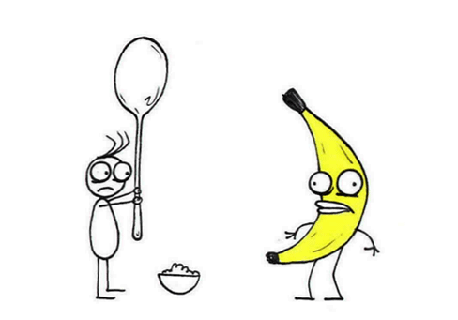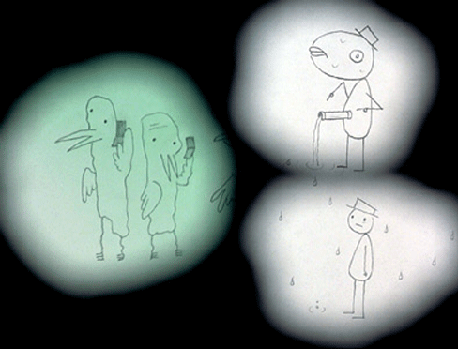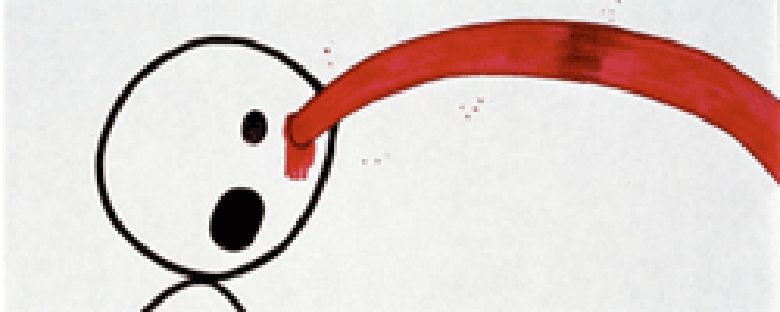Credits
Feature by: Rumsey Taylor
Posted on: 17 June 2007
Related articles:
Features: What is Animation?
Features: Don Hertzfeldt Interview
Somewhere within a universe of stark white, decorated solemnly with a few clouds and a street sign, a stick figure stands wielding an enormous spoon, at his feet a smaller, disproportionate bowl of cereal. For several seconds before voicing his obvious dilemma, the figure stands there and pulses rapidly with an anxiety that has come to distinguish every one of Don Hertzfeldt’s films. His stick figures relay a hasty, simplistic draftsmanship, but they bear a certain imperfection and vulnerability—the aforementioned one will not only remain unable to eat his cereal with a proper utensil, but by the end of the film he – and most every other character – is sucked straight off the paper into a violent black hole.
Herein, anxiety and depression are resolved in chaos, and it is chaos that inspires Hertzfeldt’s ingenuity as an animator. His work, beginning with the Rejected shorts (from which I cite above), has been widely bootlegged in the internet video circuit and has enamored him with a renown uncommon to independent animators. His films are irreverent and anxiously humorous—watching one, one is often prompted to laugh because the visuals conjure no other particular response. It is a nervous, uncertain laughter.
Aside from his films’ odd comedy, which is as recognizable as their anxiety, chaos is his films’ most telling characteristic. For one, chaos often cues Hertzfeldt’s transcendence of the medium: in Genre, the artist interacts directly with his drawing, an ambulant and disobedient rabbit, who, after refusing to enact one of the genres the film is designed to enumerate, is smashed by the artist’s fist in punishment. More significantly, chaos represents a disinterest in resolution. All of his characters either remain conflicted or they die imaginatively. Hertzfeldt’s first student film, Ah, L’amour, is the one that does not support this claim directly: comprised of a series of vignettes with identical establishment, the film concerns a man as he approaches a series of women before making some polite, impersonal statement. Most each of these exchanges results in the woman demanding her individuality, before killing the man in some increasingly gruesome manner. Ah, L’amour will have a happy ending, however: the man’s last exchange is shortened to “I have money,” which is rewarded with an embrace, a kiss, and a rainbow. It is a visual outburst of color and happiness, one so uncharacteristic that it seems parodic within Hertzfeldt’s universe of depression and violence.

Hertzfeldt’s stick figures are cohesive in their seemingly rudimentary manufacture, stringy arms and legs, rounded thoraxes and circular heads with circular eyes. They are seldom in color, which is sparingly used in his films. However, this rarity of color has a utility—often violence will be christened by an explosion of blood and the composition will house a majority of red, be it the blood draining profusely from an anus or from our pitiable bachelor, who is variably torn in two with a chainsaw or skinned before his fleshless body is generously salted. Each time this happens, the composition draped in red, the outburst of color is shocking both conceptually, as it accompanies violence, and aesthetically, as the red interrupts the predominantly black-and-white palette.
The bloodletting and anxiety become somewhat subdued in Hertzfeldt’s later films, namely the majestic The Meaning of Life. It is unquestionably his most extensively crafted work to date, a twelve-minute rumination on the nature of existence and the potential future of man, both a landmark for its ambition and production. The Meaning of Life was drawn and photographed over the course of three years; including pencil tests and photographic demos, each frame was drawn numerously. The credits include the rather assured disclaimer:
no computers were used in the animation or photography of this motion picture
The Meaning of Life opens with a sequence of people walking from either the left or right of the frame. Most of them have a sort of catch phrase they utter repeatedly. The crowd becomes more and more populated, the voices escalating to commotion. Tchaikovsky’s Nutcracker Suite plays in the background, and the voices and music reach a crescendo. Suddenly, the figures are all dead, and the film incurs its first series of edits: other compositions find other people dead in other places. The music remains, but the voices have ceased entirely.
The composition shifts rapidly at this point, thrust into the heavens to find the solar system spinning rapidly, the passage of stars across some astronomical body, and then back to Earth, now populated by an entirely new set of creatures. A father and son of some indeterminate species stand before a sunset, and the son asks, in some indecipherable language, about the meaning of life. The father replies; his response is expectedly indecipherable, but precedes a chuckle that seems to denote man’s futility in comprehending the subject.

What aesthetic Hertzfeldt has heretofore sustained is evolved rapidly in Everything Will Be OK. The short film (at 17 minutes, the first of a presupposed triptych) is comprised of animated footage and still (or sequential) photography in equal measure, each shown in haloed portions of a predominantly black screen. The elements compliment or distract others adjacent, and the narration is constant and sometimes rushed and incomprehensible. It is the story of a man, figuratively and emotionally proximate to those in Hertzfeldt’s other films, as he begins to reconcile the more mundane and permanent aspects of his existence: the amount of time allotted to daily rudimentary routines, his pathologically concerned mother, the absence of romance or meaningful relationships. Odd thoughts become increasingly sporadic. An amalgam of neuroses and paranoia, he is left hospitalized.
Everything Will Be OK is both a stylistic and thematic hallmark for Don Hertzfeldt, as lonely and anxious as his early work, but evolutionary because it considers the tenets of isolation instead of merely depicting them. Although its solemnity is familiar, it has a peculiar gravity and honesty. In lieu of violent pools of blood are more realistic disturbances in isolation, perversion, vulnerability, and the debilitation of hope. Everything Will Be OK doesn’t aspire to confront existential dilemmas as forthrightly as in The Meaning of Life; it is the more genuinely compassionate film, in contrast, inspiring empathy and not a nervous laughter. Hertzfeldt’s films are very generally about detachment, and this one – his most arresting film – depicts an attempt, however futilely, to connect.
We don’t do comments anymore, but you may contact us here or find us on Twitter or Facebook.



